Sustainability Management
Our Group's approach to sustainability
Currently, humanity is facing social issues that the entire world must solve, such as global warming, an increasing world population, hunger, poverty, etc. The goal of sustainability is to solve these social issues that hinder the sustainability of society and the environment. In this regard, we believe that many of the social issues identified in the SDGs that need to be resolved by 2030 are consistent with our Group's management philosophy and our vision for the future. Therefore, our Group aims to achieve a virtuous cycle of two sustainability pillars: "solving social issues through our business" and "a growth strategy through profit generation," which will lead to sustained improvements in our corporate value.
Basic Sustainability Policy
To further promote actions toward realization of a sustainable society by grasping the ideal form of future carbon-neutral energy cycle, circular economy, and business society free of all human rights violations, the Group established the "Basic Sustainability Policy" in October 2021 as a higher-level norm second only to its management philosophy. In addition, the Sustainability Committee was established in June 2023, and the committee revised the policy to ensure consistency with other policies and regulations.
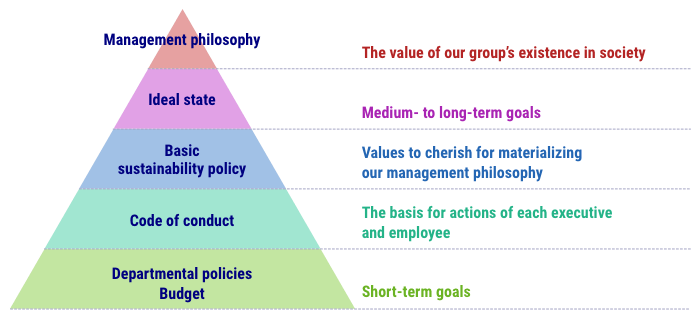
Sustainability Promotion System
In June 2023, we launched the Sustainability Committee, chaired by the President and CEO and consisting of internal directors and heads of related departments. The main roles of the committee are to implement the company-wide sustainability strategies, manage its progress, and determine the materialities. To promote sustainability strategies throughout the company, the committee's secretariat is working to foster awareness of the issues and promote understanding through active communication between the committee and relevant departments. The committee meets twice a year regularly and holds special sessions as necessary, reporting the details of its discussions to the Board of Directors. In addition, as a sub-organization of the committee, subcommittees have been established for each theme, with the heads of the relevant departments as responsible persons, to discuss and promote the identification of issues for each theme, goals, implementation plans, specific responses, etc. It also cooperates with Risk Management Committee and Compliance Promotion Committee, which handle more specialized and individual themes. These two committees are chaired by the President and CEO.
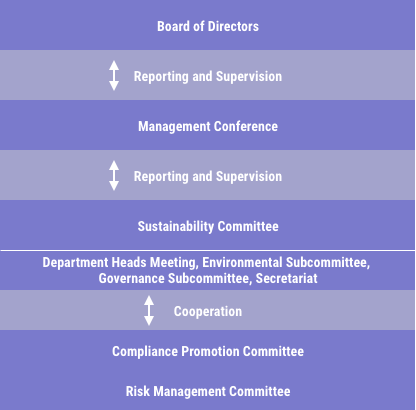
Relationship with Stakeholders
To promote sustainable management, our group believe it is important to incorporate into our business activities the requests and expectations of all the stakeholders, including employees, customers, business partners, shareholders and investors, and members of the local community. For this purpose, we strive to enhance communications with our stakeholders, and fulfill our responsibilities for disclosure of information and accountability, so as to build a good relationship with them.
| Main issues | Main communication methods | |
|---|---|---|
| Customers |
|
|
| Business Partners |
|
|
| Employees |
|
|
| Local Community |
|
|
| Environment |
|
|
| Shareholders and Investors |
|
|
Background to identifying materialities (important issues)
Currently, the world is facing the need for major change to realize a decarbonized society, against the backdrop of issues such as the various impacts of climate change, resource depletion, and environmental pollution. Furthermore, with the advent of a super-aging society and the diversification of people's lifestyles, there is an increasing demand for a healthy, fulfilling, well-being lifestyle that allows people to feel connected to society. Since the foundation, our group has evolved and developed its business by facing our customers and society with sincere attitude. In order to continue growing sustainably together with society into the future, we have identified the key issues that we must address.
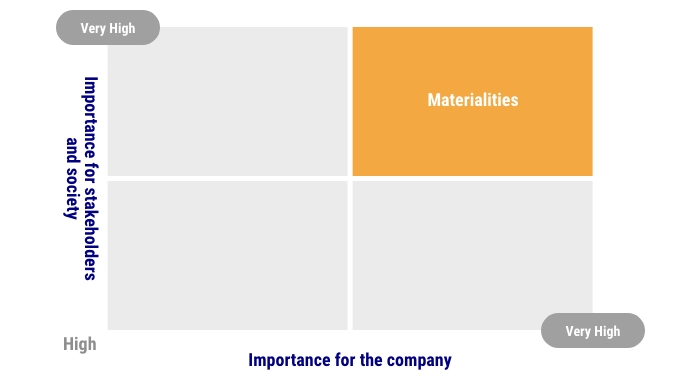
Materialities Identification Process
The identification of materialities was carried out in three steps.
In Step 1, we assessed our current situation and confirmed issues for our Group in 95 SDG-related categories (24 environment items, 21 corporate governance items, 22 social items, and 28 human resource utilization items).
In Step 2, the Sustainability Committee and the Executive Committee evaluated the materiality of each issue, taking into account factors such as the interests and expectations of stakeholders, including customers, shareholders/investors, employees, and local communities, the relationship with our Group's management philosophy and desired future vision, and the impact on our business.
In Step 3, based on the evaluation in Step 2, the President and CEO and other executive officers held multiple discussions on individual themes to select materialities and goals/KPIs, and reported them to the Board of Directors.
The Group will base its management on the materialities identified in this way, check whether its business strategies and individual businesses are aligned with the materialities, and manage its business with a constant awareness that our business activities shall contribute to society.
|
Conduct self-evaluations and checks based on domestic and international trends and SDGs-related items |
|---|---|
|
Prioritize issues based on their importance to the Group and to stakeholders |
|
Deliberations and decisions by Sustainability Committee and Management Meeting Report to the Board of Directors |
We have set initiatives, goals, and KPIs to address each materiality. We will monitor progress toward achieving our goals from fiscal 2024. Progress reports on goals and initiatives will be made at the Sustainability Committee, which meets twice a year. The content of discussions at the Sustainability Committee and the Management Meeting will be reported to and fed back from the Board of Directors, and further discussions will be held as necessary.
| Materialities | Vision for 2030 | 2024 Goals | Related SDGs | |
|---|---|---|---|---|
Contribution for dealing with social issues through business activitiesBy implementing materiality through our business activities, we aim to contribute to dealing with social issues, realizing a prosperous society for all, and improving our corporate value. |
■ Development of cutting-edge technology and creation of innovations |
|
|
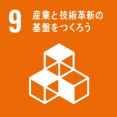
|
| Contribution to decarbonization society by developing and providing environment-friendly products |
|
|



|
|
| Response to climate change |
|
|
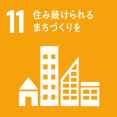


|
|
| Environmental preservation and reduction of environmental load |
|
|



|
|
| Diversity, Equity, and Inclusion |
|
|



|
|
Strengthening of management basis for increasing profitabilityStrengthening of management basis to support business activities to increase corporate value |
Establishment of supply chain management |
|
|




|
| Strengthening of governance |
|
|
||
|
Activation of human capital Mental and physical health and safety |
|
|


|
|
| Sustainable intellectual property rights strategy |
|
|


|





